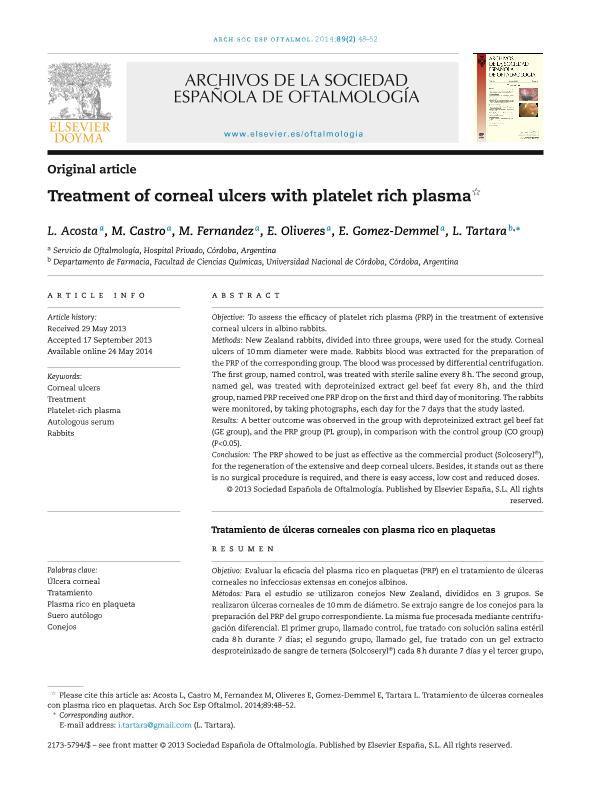Mostrar el registro sencillo del ítem
dc.contributor.author
Acosta, L.
dc.contributor.author
Castro, M.
dc.contributor.author
Fernandez, M.
dc.contributor.author
Oliveres, E.
dc.contributor.author
Gomez-Demmel, E.
dc.contributor.author
Tartara, Luis Ignacio

dc.date.available
2020-03-20T20:47:17Z
dc.date.issued
2014-02
dc.identifier.citation
Acosta, L.; Castro, M.; Fernandez, M.; Oliveres, E.; Gomez-Demmel, E.; et al.; Treatment of corneal ulcers with platelet rich plasma; Elsevier Doyma Sl; Archivos de la Sociedad Espanola de Oftalmologia; 89; 2; 2-2014; 48-52
dc.identifier.issn
0365-6691
dc.identifier.uri
http://hdl.handle.net/11336/100534
dc.description.abstract
Objetivo: Evaluar la eficacia del plasma rico en plaquetas (PRP) en el tratamiento de úlceras corneales no infecciosas extensas en conejos albinos. Métodos: Para el estudio se utilizaron conejos New Zealand, divididos en 3 grupos. Se realizaron úlceras corneales de 10mm de diámetro. Se extrajo sangre de los conejos para la preparación del PRP del grupo correspondiente. La misma fue procesada mediante centrifugación diferencial.El primer grupo, llamado control, fue tratado con solución salina estéril cada 8h durante 7 días; el segundo grupo, llamado gel, fue tratado con un gel extracto desproteinizado de sangre de ternera (Solcoseryl®) cada 8h durante 7 días y el tercer grupo, llamado PRP, recibió una gota del PRP el día 1 y el día 3 de seguimiento. Los controles fueron realizados diariamente durante los 7 días que duró el tratamiento. Se llevó a cabo un registro de los mismos a través de muestras fotográficas. Resultado: Se observó una mejor evolución en el grupo del gel extracto desproteinizado de sangre de ternera (grupo GE) y en el grupo de PRP (grupo PL), en comparación con el grupo control (grupo CO) (p < 0,05). Conclusión: El PRP demostró ser tan efectivo como lamuestra comercial (Solcoseryl®), para la regeneración de úlceras corneales profundas y extensas. Además se destaca su fácil acceso, costo y reducida posología.
dc.description.abstract
Objective To assess the efficacy of platelet rich plasma (PRP) in the treatment of extensive corneal ulcers in albino rabbits. Methods New Zealand rabbits, divided in 3 groups, were used for the study. Corneal ulcers of 10 mm diameter were made. Rabbits blood was extracted for the preparation of the PRP of the corresponding group. The blood was processed by differential centrifugation. The first group, named control, was treated with sterile saline every 8 h. The second group, named gel, was treated with deproteinized extract gel beef fat every 8 h, and the third group, named PRP received one PRP drop on the first and third day of monitoring. The rabbits were monitored, by taking photographs, each day for the 7 days that the study lasted. Results A better outcome was observed in the group with deproteinized extract gel beef fat (GE group), and the PRP group (PL group), in comparison with the control group (CO group) (P<.05). Conclusion The PRP showed to be just as effective as the commercial product (Solcoseryl®), for the regeneration of the extensive and deep corneal ulcers. Besides, it stands out as a no surgical procedure is required, and there is easy access, low cost and reduced doses.
dc.format
application/pdf
dc.language.iso
spa
dc.publisher
Elsevier Doyma Sl

dc.rights
info:eu-repo/semantics/openAccess
dc.rights.uri
https://creativecommons.org/licenses/by-nc-sa/2.5/ar/
dc.subject
Úlcera corneal
dc.subject
Tratamiento
dc.subject
Plasma rico en plaqueta
dc.subject
Suero
dc.subject
Conejos
dc.subject.classification
Farmacología y Farmacia

dc.subject.classification
Medicina Básica

dc.subject.classification
CIENCIAS MÉDICAS Y DE LA SALUD

dc.title
Treatment of corneal ulcers with platelet rich plasma
dc.title
Tratamiento de úlceras corneales con plasma rico en plaquetas
dc.type
info:eu-repo/semantics/article
dc.type
info:ar-repo/semantics/artículo
dc.type
info:eu-repo/semantics/publishedVersion
dc.date.updated
2020-03-12T18:58:24Z
dc.journal.volume
89
dc.journal.number
2
dc.journal.pagination
48-52
dc.journal.pais
España

dc.description.fil
Fil: Acosta, L.. Hospital Privado. Centro Médico; Argentina
dc.description.fil
Fil: Castro, M.. Hospital Privado. Centro Médico; Argentina
dc.description.fil
Fil: Fernandez, M.. Hospital Privado. Centro Médico; Argentina
dc.description.fil
Fil: Oliveres, E.. Hospital Privado. Centro Médico; Argentina
dc.description.fil
Fil: Gomez-Demmel, E.. Hospital Privado. Centro Médico; Argentina
dc.description.fil
Fil: Tartara, Luis Ignacio. Consejo Nacional de Investigaciones Científicas y Técnicas. Centro Científico Tecnológico Conicet - Córdoba; Argentina. Universidad Nacional de Córdoba. Facultad de Ciencias Químicas; Argentina
dc.journal.title
Archivos de la Sociedad Espanola de Oftalmologia
dc.relation.alternativeid
info:eu-repo/semantics/altIdentifier/doi/http://dx.doi.org/10.1016/j.oftal.2013.09.002
dc.relation.alternativeid
info:eu-repo/semantics/altIdentifier/url/https://www.sciencedirect.com/science/article/pii/S0365669113003328
Archivos asociados
